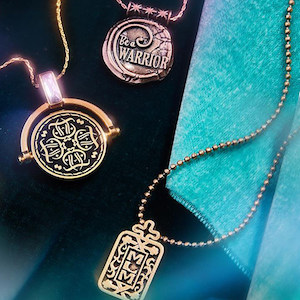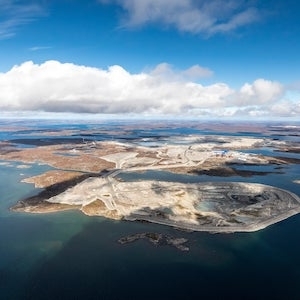
On June 9, Alex and Ani, the once big-time bangle business that has been one of the industry’s most prominent success stories for the last decade, filed for Chapter 11 in Delaware bankruptcy court.
The filing caps a number of turmoil-filled years that included several loan defaults, the COVID-19 pandemic, a disruptive computer virus, an ever-changing C-suite, and the ouster of—and legal battles with—founder and former CEO Carolyn Rafaelian.
In a first day declaration, chief restructuring officer and interim CEO Robert Trabucco said that the company plans to put most or all of its assets up for sale. If that move isn’t successful, Alex and Ani has negotiated a restructuring agreement that will see Rafaelian sell her 35% share of the company to Bathing Club LLC, which will also take on a portion of owner Lion Capital’s first-lien debt. It will also settle its current litigation with Rafaelian, who left the company last year.
Alex and Ani currently comprises 74 retail stores in the United States, Canada, and Puerto Rico; 25% of them remain closed because of the COVID-19 pandemic. Following a strategic analysis, the company has closed 37 stores since the beginning of the year, and intends to shut more going forward. It employs approximately 524 people—279 full time and 245 part time.
Its wholesale business—once 59% of revenue—now accounts for only 19%. Its website is now its biggest traffic driver, accounting for 45% of revenue.
Trabucco said the company is currently saddled with $127.4 million in debt obligations, as well as $29.1 million in unsecured trade debts. Almost all of its top unsecured creditors are mall owners like Simon Property Group.
To some, this is a sad comedown from the brand’s heyday, when it employed over 1,000 people, sold nearly 10 million bracelets a year, oversaw a fleet of 100 retail stores, and boasted a $1 billion valuation.
Trabucco, formerly the chief financial officer for Signet Jewelers, said the company’s woes were largely caused by three factors: “macro-trends driving customers away from brick-and-mortar retail”; “explosive growth in the early 2010s [that] resulted in certain operational challenges as the company’s existing infrastructure struggled to keep up with demand for its products”; and “significant turnover in management [that] disrupted key business relationships.”
Among the people watching forlornly from the sidelines is former Alex and Ani CEO Giovanni Feroce, who tells JCK: “It’s a sad day to see something like this happen, when it was so avoidable had the leadership teams that followed understood why we built it the way it was built.”
Feroce, who now runs GF Strategic Partners, was particularly distressed to see the amount of money owed to mall owners, noting that he pursued a “main street” strategy that stayed clear of shopping centers. “[That] was a crucial part of the company’s DNA,” he says.
“It’s another lesson that you don’t hire resumes, you hire people—time-tested, bona fide leaders,” he adds. “I’ll always be proud of what we built.”
Certainly, the lightning-quick rise of Alex and Ani in the first half of the 2010s is almost as startling as its equally propitious fall during the latter half.
The brand was launched in 2004 by Rafaelian, who named it after her daughters. Her father owned Rhode Island jewelry-maker Cinerama, and the company launched out of Cinerama’s basement. It initially manufactured both private-label jewelry and wire charm bracelets.
But Rafaelian soon hit it big with her signature bangle bracelet, which she had patented and often accompanied with spiritually oriented poems and cards. One notable early adopter was Gwyneth Paltrow, who sported an Alex and Ani apple necklace that Rafaelian sent her as a gift following the birth of Paltrow’s daughter, Apple.
Rafaelian’s New Agey beliefs became part of the brand’s DNA; she publicly boasted that she chose store locations based on numerology and had every piece of Alex and Ani jewelry blessed by a shaman.
In 2010, the company’s fortunes changed with the hiring of Feroce—a former militarily man, state senator, and head of an eyeglasses company—according to an exhaustive investigative report on the company by Aaron Gell, published on Medium.
In Feroce’s first year, sales hit a reported $5 million. Two years later, they hit $75 million, causing private equity firm JH Partners to take a stake in the company.
Feroce, who also served as the company’s chief marketing officer, knew how to make a splash; in 2013, he spent $2 million on an ad that aired during the Super Bowl. The company’s site received so much traffic it briefly shut down, and Alex and Ani trended on Twitter. Another ad, which noted that the brand was made in America, ran during the big game the following year.
But that year turned out to be a fateful one for the company. Feroce, always a bit of a mismatch with Rafaelian, left the company in March, at the latter’s request, according to Trabucco’s declaration. Six months later, Rafaelian took over as permanent CEO. Almost all the company’s then-leadership ended up either leaving or quitting.
But the brand remained strong enough that JH Partners was bought out by London-based Lion Capital, which paid $360 million for 40% stake of the company. That gave Alex and Ani a $1 billion valuation—“the rare unicorn with no tech startup pretensions,” Gell wrote.
In 2015, the brand scored a tremendous coup when Sterling placed its products in 108 Jared stores, a strong vote of confidence that was, it turns out, misplaced. When the brand underperformed, Sterling was stuck with millions in inventory, sparking a lawsuit with Alex and Ani.
While Rafaelian remained in charge, the rest of the company’s C-suite became a revolving door. Two attempts to hire a president failed; former Yankee Candle CEO Harlan Kent barely lasted a year, as did Cindy DiPietrantonio, who departed along with the company’s then–chief financial officer, Bob Woodruff, at the end of 2018. Rafaelian eventually assumed the title of president and CEO and hired as chief financial officer 26-year-old Andrea Ruda, who came from the office of the company’s attorney, celebrity lawyer Mark Geragos.
Despite all this turmoil, Alex and Ani’s core business appeared strong. In 2016, it was publicly stating that its sales had topped $500 million a year, and was swatting away IPO talk. Trabucco’s declaration, however, said the company’s revenue peaked at $340 million in 2015.
In 2016, a consortium of banks led by Bank of America granted Alex and Ani a $170 million term loan, which largely went to its reported $100 million purchase of Cinerama, its primary manufacturer. While the company could now argue it was vertically integrated, the Cinerama purchase also represented a windfall for its owners, Rafaelian and her sister. The company founder was hailed on the cover of Forbes as the “bangle billionaire” and one of the world’s richest self-made women.
In 2018, following in the footsteps of Pandora, Alex and Ani announced plans to slash the number of independent retailers that carried the brand—which then numbered 1,800 in the United States—and move sales to its website and fleet of concept stores. It said it planned to open 25 to 30 new concept stores a year.
But strains were beginning to show. In 2018, revenue fell to $224 million. The Cinerama purchase left the company with considerable debt. In 2019, Bank of America declared that Alex and Ani had defaulted on its credit line. In return, the company sued the bank, in a suit lawyer Harmeet Dhillon’s office widely distributed to the financial press.
Alex and Ani’s complaint dubbed the default “fraudulent,” and said it was sparked by the bank’s “greed and sexism.” It alleged that the bank was charging the company millions of fees that were “driving [it] towards bankruptcy,” depressing sales because it couldn’t pay vendors.
The suit was withdrawn a month later, and Lion Capital eventually negotiated a settlement, which involved taking over much of Rafaelian’s shares. The firm now reportedly had control of 59% of the company. In 2020, Trabucco was appointed interim CEO, after Rafaelian left the company. Scott Burger, former head of the North American division for once-archrival Pandora, has chaired the company since 2020.
But just as the restructuring was about to kick in, in February 2020, the company fell victim to a ransomware virus, known as Ryuk, which disrupted its operations for several months. Then came COVID-19, which forced most of its stores to close. The company furloughed 79% of its employees, and fired over 315 others, including Rafaelian.
The company defaulted again on its credit agreements in July and October 2020. The bank waived those defaults, but when Alex and Ani started talking to the bank, “it became clear…the first-lien lenders were not interested in supporting a comprehensive restructuring, and no longer intended to support the company as a going concern,” Trabucco said in his declaration.
In February 2021, the company defaulted again, and Bank of America pressed for a sale. Lion Capital was interested in continuing the business, and assumed a lot of the first-lien debt. It also called in restructuring consultants, which led to the current filing.
“The key to achieving the restructuring is speed and cooperation,” said Trabucco in the declaration. “In an ever-shifting retail landscape that has seen dozens of casualties in recent years, Alex and Ani will work collaboratively with all parties in interest to ensure that it remains a going concern for many years to come.”
Its bankruptcy papers can be seen here.
Also filing for Chapter 11 were related entities A and A Shareholding Co.; Alex and Ani International; Alex and Ani Retail; Alex and Ani Assembly; Alex and Ani California; Alex and Ani Canada; Alex and Ani Puerto Rico; and Alex and Ani South Seas.
(Photo courtesy of Alex and Ani)
- Subscribe to the JCK News Daily
- Subscribe to the JCK Special Report
- Follow JCK on Instagram: @jckmagazine
- Follow JCK on X: @jckmagazine
- Follow JCK on Facebook: @jckmagazine






